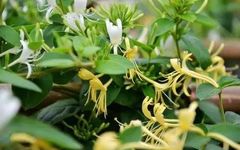|
Honeysuckle (Jin Yin Hua) has the effects of clearing heat and detoxifying, as well as dispersing wind-heat. It can be used as an adjunct treatment for allergic dermatitis, promoting the phagocytic function of white blood cells and alleviating inflammatory damage to the skin. |
Doctors say: It clears the throat and moistens the throat, regulates immunity, lowers blood lipids, and has anti-inflammatory properties. Honeysuckle, also known as Ren Dong Hua (忍冬花), Yin Hua (银花), Jin Hua (金花), and Shuang Hua (双花), belongs to the Caprifoliaceae family and is the dried flower bud of Lonicera japonica (忍冬) and related species. It has a fragrant and slightly bitter taste, mainly produced in Henan and Shandong provinces of China. The National Health Commission has defined it as a raw material for health food, with key active components including chlorogenic acid, luteolin, and volatile oils. Its main physiological functions include clearing heat and detoxifying, regulating immunity, lowering blood lipids, and anti-inflammatory effects.Effects and Functions of HoneysuckleThe term “Honeysuckle” originates from Li Shizhen’s work “Compendium of Materia Medica”. It is called Honeysuckle because it does not shed its leaves even in the cold winter. Honeysuckle has strong adaptability and is distributed across most regions of China, primarily cultivated artificially.Honeysuckle not only has ornamental value but also medicinal value. It is a commonly used traditional Chinese medicine with a cold nature and sweet taste, known for its heat-clearing and detoxifying effects. Medical research shows that the pharmacologically active components in Honeysuckle, such as chlorogenic acid and luteolin glycosides, can inhibit various pathogenic bacteria and viruses causing upper respiratory infections, helping to resist viral invasions and enhance immunity. It can also treat various diseases such as heat stroke, diarrhea, influenza, carbuncles, acute and chronic tonsillitis, and periodontal disease, making it widely applicable.1. Boil Honeysuckle vines in water and apply it to the skin or use it for bathing to help relieve skin itching and eliminate eczema.2. Giving poultry Honeysuckle water can also prevent animal febrile diseases, dysentery, pneumonia, and other conditions.3. Boiling Honeysuckle with Chrysanthemum can be consumed as a refreshing drink, helping to relieve summer heat and quench thirst, as well as clear the liver and improve eyesight.4. Honeysuckle can inhibit and kill pathogenic bacteria in the throat, providing anti-infection effects for the elderly and children.5. Regular consumption of Honeysuckle infusion or decoction is beneficial for treating and recovering from conditions such as wind-heat eye redness, sore throat, obesity, liver heat syndrome, and liver heat type hypertension.Due to Honeysuckle’s special effects, many people enjoy drinking Honeysuckle-infused water or consuming functional beverages made from it.In fact, combining Honeysuckle with other ingredients can enhance its effects! For example, Honeysuckle and Chrysanthemum can clear heat and relieve summer heat; Honeysuckle and mint can reduce internal heat and eliminate bad breath; Honeysuckle and aloe can generate fluids and quench thirst; Honeysuckle and hawthorn can improve appetite; Honeysuckle and licorice can treat oral ulcers and pharyngitis. Additionally, Honeysuckle can be paired with goji berries, red dates, honey, and more.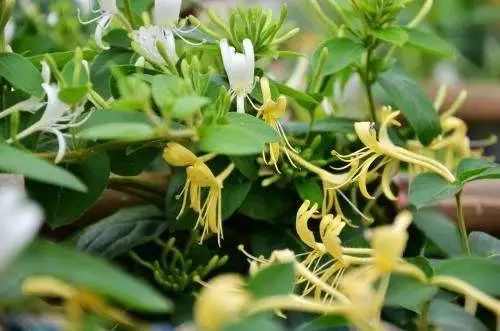 However, we need to be aware that while Honeysuckle is beneficial, there are someprecautions to consider. If you have the following conditions, you should use or consume Honeysuckle with caution!1. Honeysuckle tea or beverages are not suitable for long-term consumption due to their cold nature. Long-term excessive consumption can affect the normal function of the spleen and stomach, especially for individuals with a cold constitution or women during menstruation, as it may lead to a weakened constitution.2. When consuming Honeysuckle, do not take it simultaneously with nourishing Chinese patent medicines, as this may cause adverse reactions and reduce efficacy.3. Patients with hypertension, diabetes, heart disease, or hepatitis B should avoid consuming Honeysuckle beverages or foods made with Honeysuckle, as it may worsen their conditions.4. Limit the intake of cold Honeysuckle drinks and avoid drinking overnight Honeysuckle tea. Warm Honeysuckle tea is necessary to exert its medicinal effects, while overnight Honeysuckle tea may cause diarrhea.Like many other important herbs, Honeysuckle is a treasure, but we must learn to use it correctly to maximize its benefits and avoid counterproductive effects.References:[1] “Using Honeysuckle to Bathe for Summer Heat Rashes”. Health Times. 2018-06-19[2] “Honeysuckle Tea Should Not Be Drunk Daily”. Health Times. 2017-08-15[3] “Q&A: Can a Bottle of ‘Peach Water’ Prevent Heat Rashes in Hot Weather?”. The Paper. 2018-06-29
However, we need to be aware that while Honeysuckle is beneficial, there are someprecautions to consider. If you have the following conditions, you should use or consume Honeysuckle with caution!1. Honeysuckle tea or beverages are not suitable for long-term consumption due to their cold nature. Long-term excessive consumption can affect the normal function of the spleen and stomach, especially for individuals with a cold constitution or women during menstruation, as it may lead to a weakened constitution.2. When consuming Honeysuckle, do not take it simultaneously with nourishing Chinese patent medicines, as this may cause adverse reactions and reduce efficacy.3. Patients with hypertension, diabetes, heart disease, or hepatitis B should avoid consuming Honeysuckle beverages or foods made with Honeysuckle, as it may worsen their conditions.4. Limit the intake of cold Honeysuckle drinks and avoid drinking overnight Honeysuckle tea. Warm Honeysuckle tea is necessary to exert its medicinal effects, while overnight Honeysuckle tea may cause diarrhea.Like many other important herbs, Honeysuckle is a treasure, but we must learn to use it correctly to maximize its benefits and avoid counterproductive effects.References:[1] “Using Honeysuckle to Bathe for Summer Heat Rashes”. Health Times. 2018-06-19[2] “Honeysuckle Tea Should Not Be Drunk Daily”. Health Times. 2017-08-15[3] “Q&A: Can a Bottle of ‘Peach Water’ Prevent Heat Rashes in Hot Weather?”. The Paper. 2018-06-29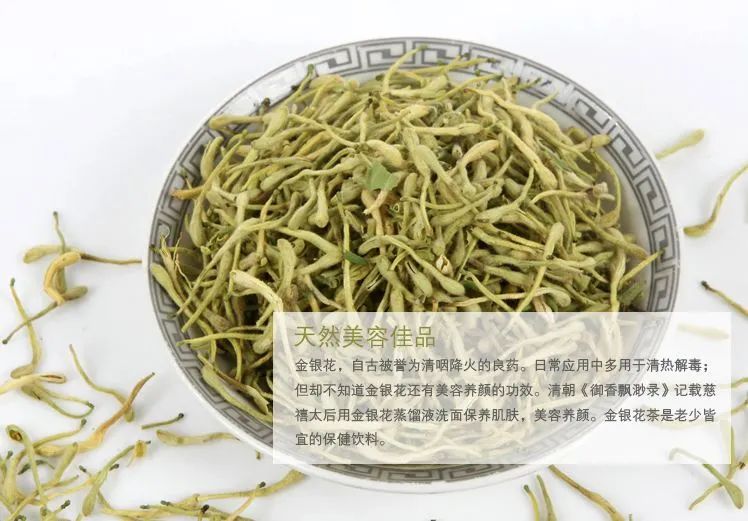 [Pharmacological Knowledge][Chinese Medicine Name] Honeysuckle (Jin Yin Hua)[Alias] Ren Dong Hua, Shuang Hua, Er Hua, Yin Hua, Lu Ci Hua, Jin Hua, Shuang Bao Hua, Jin Teng Hua.[English Name] Lonicerae Japonicae Flos.[Medicinal Part] Flower buds of the plant Lonicera japonica Thunb. from the Caprifoliaceae family.[Plant Morphology] A perennial semi-evergreen woody vine. The old stems are brown, and the young branches are green, densely covered with soft hairs. Leaves are opposite and ovate. Flowers grow in pairs in the axils; the corolla is white when first opened and turns yellow later, covered with soft hairs and glandular hairs. The corolla tube is long and the upper lip has 4 shallow lobes, while the lower lip is narrow and not lobed; there are 5 stamens extending beyond the corolla; the ovary is inferior. The berries are spherical and turn black when ripe. Flowering occurs from April to June, and fruiting from August to October.[Distribution] Grows in hills, forest edges, and hedges; widely cultivated. Distributed in most regions of the country.[Harvesting and Processing] Collected in early summer before flowering, impurities removed, and dried.[Herbal Characteristics] The herbal material of Honeysuckle is rod-shaped, thicker at the top and thinner at the bottom, slightly curved. The surface is yellow-green and densely covered with short soft hairs. The calyx is green and 5-lobed at the tip. The open flower has a tubular corolla with a two-lipped tip; there are 5 stamens attached to the tube wall, yellow; the pistil is single, and the ovary is hairless. It has a fragrant aroma, with a mild and slightly bitter taste.[Nature and Taste] Cold in nature, sweet in taste. It enters the Lung, Heart, and Stomach meridians.[Effects and Functions] Clears heat and detoxifies, cools and disperses wind-heat. It belongs to the category of heat-clearing and detoxifying herbs.
[Pharmacological Knowledge][Chinese Medicine Name] Honeysuckle (Jin Yin Hua)[Alias] Ren Dong Hua, Shuang Hua, Er Hua, Yin Hua, Lu Ci Hua, Jin Hua, Shuang Bao Hua, Jin Teng Hua.[English Name] Lonicerae Japonicae Flos.[Medicinal Part] Flower buds of the plant Lonicera japonica Thunb. from the Caprifoliaceae family.[Plant Morphology] A perennial semi-evergreen woody vine. The old stems are brown, and the young branches are green, densely covered with soft hairs. Leaves are opposite and ovate. Flowers grow in pairs in the axils; the corolla is white when first opened and turns yellow later, covered with soft hairs and glandular hairs. The corolla tube is long and the upper lip has 4 shallow lobes, while the lower lip is narrow and not lobed; there are 5 stamens extending beyond the corolla; the ovary is inferior. The berries are spherical and turn black when ripe. Flowering occurs from April to June, and fruiting from August to October.[Distribution] Grows in hills, forest edges, and hedges; widely cultivated. Distributed in most regions of the country.[Harvesting and Processing] Collected in early summer before flowering, impurities removed, and dried.[Herbal Characteristics] The herbal material of Honeysuckle is rod-shaped, thicker at the top and thinner at the bottom, slightly curved. The surface is yellow-green and densely covered with short soft hairs. The calyx is green and 5-lobed at the tip. The open flower has a tubular corolla with a two-lipped tip; there are 5 stamens attached to the tube wall, yellow; the pistil is single, and the ovary is hairless. It has a fragrant aroma, with a mild and slightly bitter taste.[Nature and Taste] Cold in nature, sweet in taste. It enters the Lung, Heart, and Stomach meridians.[Effects and Functions] Clears heat and detoxifies, cools and disperses wind-heat. It belongs to the category of heat-clearing and detoxifying herbs.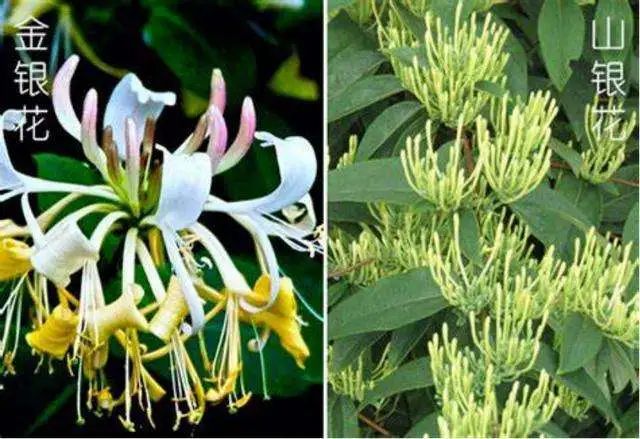 [Clinical Applications] Dosage: 6-15 grams, decocted in water; or used in pills or powders. For external use: appropriate amount, pounded and applied. Used to treat carbuncles, sore throat, erysipelas, heat-toxicity dysentery, wind-heat colds, and febrile diseases. Currently, it is often made into various preparations for treating throat inflammation, tuberculosis with respiratory infections, pneumonia, bacterial dysentery, surgical purulent infections, cervical erosion, and acute ophthalmic inflammation.[Pharmacological Research] It has antimicrobial, antitoxic, anti-inflammatory, antipyretic properties, promotes phagocytic function of inflammatory cells, lowers blood lipids, has central nervous system stimulation, anti-fertility effects, prevents gastric ulcers, and stimulates uterine activity. In vitro experiments show that Honeysuckle decoction and alcohol extract have certain inhibitory effects on various Gram-positive and Gram-negative bacteria, including Staphylococcus aureus, Streptococcus pneumoniae, Escherichia coli, and Mycobacterium tuberculosis. Honeysuckle’s decoction, infusion, and purified liquid have good bactericidal and inhibitory effects on Streptococcus mutans, with the antibacterial effect increasing significantly with concentration.[Chemical Components] Contains luteolin, inositol (1%), volatile oils, terpenes, phenolic acids, and other chemical components, including chlorogenic acid, isochlorogenic acid, ginkgolide, β-sitosterol, and soy sterol-D-glucoside.[Precautions] Use with caution in cases of spleen and stomach deficiency and cold sores belonging to Yin syndromes.[Compatible Formulas] For reference only 1. For severe pain from sores with purple-black discoloration: 60 grams of Honeysuckle branches and leaves (chopped), 120 grams of Astragalus, and 30 grams of Licorice. Finely chop, add one liter of wine, seal in a bottle, and simmer for 3-4 hours. Strain and take the decoction. (From “Essential Techniques of Life”) 2. For carbuncles, sores, and pain relief: 120 grams of Honeysuckle and 30 grams of fried Licorice. Grind into a coarse powder, take 12 grams, and decoct with one cup of water and wine until reduced to one cup, strain, and take warm. (From “Health Treasure”) 3. For early-stage carbuncles: 240 grams of Honeysuckle, boiled in ten cups of water until reduced to two cups, add 60 grams of Angelica, and boil until reduced to one cup, take all at once. (From “Secrets of the Cave”) 4. For breast abscesses with severe pain: 7.5 grams each of Honeysuckle, Angelica, honey-fried Astragalus, and Licorice. Prepare as a decoction, add half a cup of wine, and take warm after meals. (From “Essentials of Yin and Yang”) 5. For chronic breast lumps that gradually enlarge and become red and watery: 15 grams each of Honeysuckle and raw Astragalus, 24 grams of Angelica, 5.4 grams of Licorice, and 50 pieces of bitter orange leaves, decocted with equal parts of water and wine. (From “Bamboo Forest Gynecology”)
[Clinical Applications] Dosage: 6-15 grams, decocted in water; or used in pills or powders. For external use: appropriate amount, pounded and applied. Used to treat carbuncles, sore throat, erysipelas, heat-toxicity dysentery, wind-heat colds, and febrile diseases. Currently, it is often made into various preparations for treating throat inflammation, tuberculosis with respiratory infections, pneumonia, bacterial dysentery, surgical purulent infections, cervical erosion, and acute ophthalmic inflammation.[Pharmacological Research] It has antimicrobial, antitoxic, anti-inflammatory, antipyretic properties, promotes phagocytic function of inflammatory cells, lowers blood lipids, has central nervous system stimulation, anti-fertility effects, prevents gastric ulcers, and stimulates uterine activity. In vitro experiments show that Honeysuckle decoction and alcohol extract have certain inhibitory effects on various Gram-positive and Gram-negative bacteria, including Staphylococcus aureus, Streptococcus pneumoniae, Escherichia coli, and Mycobacterium tuberculosis. Honeysuckle’s decoction, infusion, and purified liquid have good bactericidal and inhibitory effects on Streptococcus mutans, with the antibacterial effect increasing significantly with concentration.[Chemical Components] Contains luteolin, inositol (1%), volatile oils, terpenes, phenolic acids, and other chemical components, including chlorogenic acid, isochlorogenic acid, ginkgolide, β-sitosterol, and soy sterol-D-glucoside.[Precautions] Use with caution in cases of spleen and stomach deficiency and cold sores belonging to Yin syndromes.[Compatible Formulas] For reference only 1. For severe pain from sores with purple-black discoloration: 60 grams of Honeysuckle branches and leaves (chopped), 120 grams of Astragalus, and 30 grams of Licorice. Finely chop, add one liter of wine, seal in a bottle, and simmer for 3-4 hours. Strain and take the decoction. (From “Essential Techniques of Life”) 2. For carbuncles, sores, and pain relief: 120 grams of Honeysuckle and 30 grams of fried Licorice. Grind into a coarse powder, take 12 grams, and decoct with one cup of water and wine until reduced to one cup, strain, and take warm. (From “Health Treasure”) 3. For early-stage carbuncles: 240 grams of Honeysuckle, boiled in ten cups of water until reduced to two cups, add 60 grams of Angelica, and boil until reduced to one cup, take all at once. (From “Secrets of the Cave”) 4. For breast abscesses with severe pain: 7.5 grams each of Honeysuckle, Angelica, honey-fried Astragalus, and Licorice. Prepare as a decoction, add half a cup of wine, and take warm after meals. (From “Essentials of Yin and Yang”) 5. For chronic breast lumps that gradually enlarge and become red and watery: 15 grams each of Honeysuckle and raw Astragalus, 24 grams of Angelica, 5.4 grams of Licorice, and 50 pieces of bitter orange leaves, decocted with equal parts of water and wine. (From “Bamboo Forest Gynecology”)
| =====Previous Classics======Traditional Chinese Medicine – The Efficacy and Functions of Chicken Inner GoldTraditional Chinese Medicine – The Efficacy and Functions of Stone CalamusTraditional Chinese Medicine – The Efficacy and Functions of MintThe Effects and Precautions of Drinking Licorice InfusionTraditional Chinese Medicine – The Efficacy and Functions of Cicada SloughTraditional Chinese Medicine – The Efficacy and Functions of Summer WithoutDiscovering the “Best Partner” of Astragalus: Drink for a Month to Eliminate Dampness and Cold, Thank Your Liver and KidneysWhat Time Counts as Staying Up Late? Life Guide – Preventing Acute Myocardial Infarction: Knowledge You Should MasterThe Efficacy, Functions, Selection, and Proper Consumption of Honey: This Article Covers It AllEssential Skills for First Aid in Trauma: Hemostasis and Bandaging |
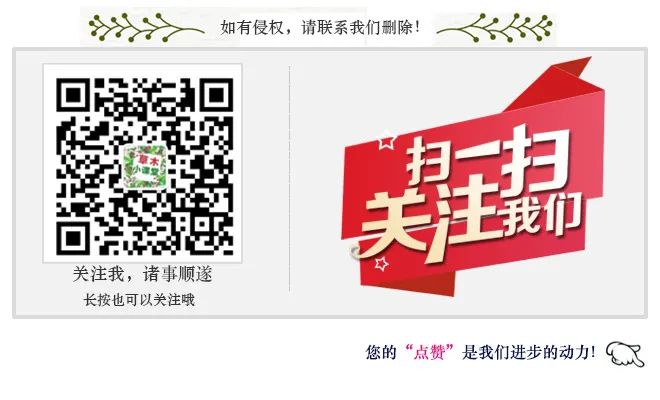
Note:Please do not use medications without medical advice; follow your doctor’s instructions.

